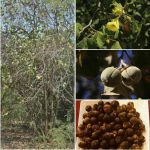Side Effects and Health Benefits of Goron Tula (Azanza garckeana).
Azanza garckeana (F. Hoffm.) Exell & Hillc. Synonyms and other names: Thespesia garckeana F.Hoffm., Shantzia garckeana (F. Hoffm.) Lewton (Botanical name) or African chewing gum, Azanza, Quarters, Snot apple, Tree hibiscus, Wild hibiscus (English) or Goron Tula (Hausa): A tree with many nutritional and medicinal properties
DESCRIPTION AND OCCURRENCE
Goron Tula is a small to medium sized tree, normally 3-13 m tall and up to 25 cm diameter at breast height (DBH). It has been found as tall as 20 m and as thick as 45 cm DBH. The bark is rough, dark-grey or brown in colour and cracks lengthwise and becomes flaky. The leaves are alternate, simple, up to 20 x 20 cm, but usually about 8 to 12 cm long. The upper surface is covered with harsh stellate hairs and the lower surface with soft hairs. Flowers are showy, yellow aging to orange-red, with a dark reddish-purple patch at the base of each petal.
The flowers are up to 6 cm in diameter but do not expand fully. They are borne solitary in the axils of the leaves near the branch-ends. The flower is bisexual with all parts in fives. The fruit is an almost spherical woody capsule, 2.5 to 4 cm in diameter, with dense short hairs. It is divided into five sections and when mature it is yellowish to brownish-green in colour. It opens slowly. The fleshy and sticky pulp inside contains five seeds, one in each chamber.
The seed is hemispherical 7×10 mm and covered in brownish woolly floss. Goron Tula is indigenous to Eastern and Southern Africa. It can be found from the South of Kenya into Tanzania, Malawi, Zambia, Zimbabwe, and Mozambique extending into Northeastern Transvaal in South Africa and to the west into the Eastern-most part of Botswana around Francistown and in the Caprivi Strip. To the north found in Sudan, in the Jebel Marra and Nuba Mountains at altitudes of 1150-1350 m.
It has possibly been introduced and naturalised in Nigeria, where it can be found in Tula, Kaltungo Local Government Area of Gombe State and in Michika in Adamawa State.
Health Benefits of Goron Tula
USES: The fruits are the most useful part of Azanza garckeana. The fruits are eaten while slightly green or when ripe. The fruits have very high energy content of about 8.1 kJ/g. They are consumed fresh or dried and stored and used in porridge as a relish. The fruits are often marketed locally. The fruits can be soaked in a small amount of water to make jelly; they can also be boiled and used as relish or made into porridge.
100 mg of Goron Tula fruits contain: 320 mg vitamin C, 127 mg calcium, 12 mg Fe, 96 mg magnesium, 1360 mg potassium, 12 mg zinc, 3 mg vitamin E, 1 mg B1 and 1 mg B2. Therefore, it can be said that the fruits are very nutritious and their consumption may help in the prevention of anemia, hypertension, heart disease and many other non-communicable diseases.
Leaves are used for making relish and can be burned to produce salt. The leaves are rich in Mg, Fe, Zn, vitamin E and vitamin C. Root infusion of A. garckeana is taken orally as remedy for chest pains, cough and menstruation in Nigeria, Zimbabwe and Kenya.
The root and stem bark decoction of A. garckeana is taken orally as remedy for gonorrhoea, sexually transmitted diseases and syphilis in Malawi, Nigeria and Zambia. The leaf, stem, root decoction or ripe fruits of A. garckeana are taken orally as remedy for infertility and liver problems in Botswana, Kenya, Malawi and Nigeria.
In Nigeria, fruit poultices are applied on abscesses and ripe fruits are taken orally as aphrodisiac. In Sudan, ripe fruits are taken orally for anemia (this may be due to the high Fe and vitamin content), while in Tanzania, the root decoction is taken by pregnant women to induce labour.
In Zimbabwe, the root decoction of A. garckeana is taken orally as antiemetic, as remedy for madness or mental illness, retained placenta and root infusion is dropped into ear as remedy for earache.
In the DRC, the leaf or root decoction of A. garckeana is taken orally as remedy for diabetes, edema, epilepsy and membrane rupture. Goron Tula is believed to promote fertility and menstruation problems.
In Malawi, the root decoction of A. garckeana is taken orally for fever while in Zambia, people suffering from malaria are advised to eat raw fruit of the species or cook the fruit and eat it as relish. The root decoction of A. garckeana is mixed with roots of Stereospermum kunthianum Cham. (Sansami in Hausa) and taken orally as remedy for asthma in Malawi.
A number of pharmacological activities of A. garckeana have been reported in literature justifying some of its ethnomedicinal uses.
These include anti-bacteria, antifungal, anti-hyperglycemic (lowering of blood glucose), antimalarial, antioxidant and iron absorption activities.
Side effects of goron tula
There have been fears that goron tula is not good in pregnancy because it could cause miscarriage and pregnancy loss however, this is not scientifically proven yet. However, if you are pregnant, it is advisable to avoid goron tula to prevent any possible side effects. .

These are the thoughts of:
Sa’eed Halilu Bawa
Senior Lecturer (Associate Professor) at University of the West Indies, St. Augustine Campus, Trinidad.
Studied Food and Nutrition Sciences, Dietetics at Kaduna Polytechnic, Nigeria; Warsaw University of Life Sciences, Poland.
























